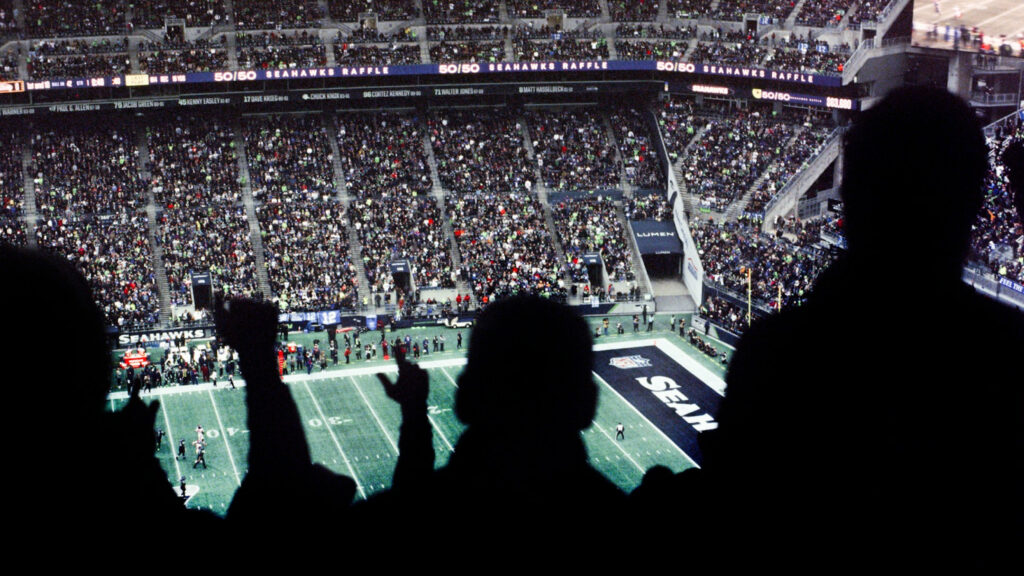
HOME / BLOG / STATISTICS
Super Bowl Advertising Statistics 2025: 96+ Stats & Insights [Expert Analysis]
- October 17, 2025
- Bill Nash
- 3:33 pm
In this comprehensive guide, we’ll break down the latest Super Bowl advertising statistics (2025) for marketers to learn from. Whether you’re a CMO, media buyer, or digital strategist—you’ll gain real insights and benchmarks to inform your campaigns.
Table of Contents
Viewership & reach
Super Bowl LIX (2025) averaged 127.7 million U.S. viewers across TV + streaming — the largest average audience for a Super Bowl.
The 2025 broadcast peaked around 137.7 million viewers during the second quarter.
Nielsen’s revised “reach” measure counted ~191.9 million people who watched at least one minute of Super Bowl LIX.
Streaming contributed meaningfully: streaming platforms (Tubi, NFL Digital, Telemundo streaming) reached ~14.5 million average minute audience in 2025.
The halftime show (Kendrick Lamar, 2025) averaged 133.5 million viewers — a halftime-show record.
Spanish-language telecasts (Fox Deportes + Telemundo) averaged roughly 1.8–1.9 million viewers in 2025.
Super Bowl TV broadcasts continue to outsize most other U.S. telecasts: the game has repeatedly been the single most-watched U.S. program each year it peaks.
In recent years, multi-platform measurement (network + streaming + out-of-home) has increased reported Super Bowl reach.
The average Super Bowl household reach far exceeds typical primetime shows — hundreds of millions will see at least one minute in many years.
Year-to-year viewership can vary ± a few percent, but the Super Bowl remains extremely consistent as a mass reach event.
Streaming viewership growth is compressing the gap between linear and digital reach — many advertisers buy both linear and streaming packages.
Super Bowl viewership spikes are often concentrated around the first half and halftime; ad exposure is highest in Q2 historically.
Nonlinear viewing (clips, on-demand rebroadcasts) boosts total ad impressions after the game.
The Super Bowl consistently drives massive social engagement and post-game ad views on platforms (YouTube, X, TikTok).
Advertisers factor in both “live” A/V reach and extended social/streaming life when valuing an ad.
Cost & economics
In 2025, a 30-second Super Bowl spot cost advertisers about US$8 million on average.
That $8M equates to roughly $266,666 per second for a 30-second ad. (Simple math from the $8M figure.)
Production budgets for top-tier Super Bowl spots often add US$1–5 million (or more) to the total campaign cost.
Major networks earn hundreds of millions in ad sales from the Super Bowl broadcast — Fox reportedly earned well over US$600M in 2025 ad revenue.
Advertisers frequently pre-buy bundles that include post-game digital/promotional inventory in addition to the TV spot.
Premium placement (Q1, Q2, halftime adjacency) commands higher rates than other quarters.
Some brands split their buys into multiple 15- and 30-second spots to stretch messaging and creative testing.
CPM (cost per thousand viewers) for Super Bowl ads can be competitive when calculated vs. the sheer scale of reach; CPMs vary widely by placement and year.
Sponsors often activate expensive creative/ecosystem spends (talent, stunts, microsites) that exceed airtime price.
Agencies charge premium planning and production fees for Super Bowl campaigns due to complexity and stakes.
Smaller brands sometimes join with partners or run online-only campaigns if they can’t absorb full linear rates.
Some advertisers achieve broader ROI by measuring downstream sales lifts and social lift; cost justification varies by category.
Auto, beverage, snack, and tech brands historically pay the largest share of Super Bowl ad budgets.
As airtime costs climb, advertisers increasingly optimize for multi-channel extension (social, OLV, influencer) to capture more value.
When airtime spikes, production and celebrity fees often rise in parallel, increasing total campaign spend.
Advertisers, volume & categories
Recent Super Bowls have seen 50–70 unique national advertisers in a single broadcast.
The number of brands advertising at the Super Bowl increased substantially over the past decade.
In 2024/2025 many categories — travel, CPG, automotive, tech, streaming services — increased their presence.
Some brands buy two or more spots in the same game to run multipart storytelling.
Beverage brands (alcoholic and nonalcoholic) consistently use the Super Bowl to launch or reinforce brand stories.
Automakers often run high-production spots that highlight product features and brand prestige.
Food/snack brands (e.g., Reese’s) have been standout performers in recent audience engagement metrics.
Streaming platforms increasingly buy Super Bowl slots to promote shows and subscription offers.
Newer advertisers (startups or category disruptors) sometimes use single high-impact ads plus a digital retargeting plan.
Category mix and creative tone shift year to year based on cultural moments and trending topics.
Celebrity appearances in Super Bowl ads remain common — a majority of top ads often include at least one known talent.
Celebrity-led ads tend to receive higher immediate social attention (shares, views) post-game.
Some brands use humor as a dominant creative approach; emotional storytelling is another recurrent top performer.
Political or overtly controversial ads are rare; networks and the NFL manage sponsorship and content approvals tightly.
Many advertisers test multiple creative cuts and choose final versions after pre-screening with focus groups.
Recall, effectiveness & measurement
Ipsos research showed 87% of Super Bowl viewers could remember at least one advertiser unaided (historical Ipsos finding).
The average viewer historically could recall ~3.5 advertisers from the Super Bowl unaided.
Brand lift studies often measure ad recall, awareness, favorability, and purchase intent post-game.
Some third-party analyses rank ads by “engagement” (views, shares, earned media) to estimate relative performance.
Veylinx and other firms have reported measurable short-term demand lifts from Super Bowl ads in tested categories (double-digit lifts in some cases).
Ads that end on an emotional high tend to produce stronger recall and brand lift.
Pre-game earned media and teaser campaigns help raise baseline awareness and improve in-game recall.
Marketers increasingly combine first-party measurement (site traffic, conversions) with third-party brand tracking.
Social video views (YouTube, TikTok) often outpace linear impressions in the weeks after the game for successful ads.
Some advertisers use custom landing pages / QR codes to convert viewers immediately after the ad airs.
Ad effectiveness varies by category — some CPG brands see immediate sales lifts; others focus on long-term brand equity.
Super Bowl ad campaigns are often measured across multiple KPIs — awareness, social reach, earned impressions, and sales lift.
A single memorable creative idea can outperform a technically flashy but forgettable spot in long-term brand metrics.
Brands increasingly perform A/B tests in digital channels to refine offers tied to Super Bowl creative.
The post-game “halo” (earned media + press coverage) often multiplies the ad’s effective impressions by several times the live audience.
Creative & production trends
Many 2020s Super Bowl spots favor big production values, cinematic direction, and VFX.
There’s a rising trend of multi-part campaigns: TV spot + social cuts + behind-the-scenes content.
Ads increasingly plan for “short-form” edits (6–15-second cuts) for social distribution.
User engagement metrics post-airing (views, comments, shares) frequently influence future spend decisions.
Some advertisers use surprise reveals or celebrity cameos as tactical hooks to boost shareability.
Brands sometimes produce multiple creative versions to localize humor or references for different audiences.
Music licensing and original scoring are big elements of production cost and perceived quality.
Directors with film/TV pedigree are often hired to create cinematic spots.
Practical stunts and location shoots add risk and cost but can create standout moments.
A minority of advertisers opt for deliberately low-fi or quirky ads to stand out among glossy spots.
“Purpose” and social-message ads appear periodically; their effectiveness is mixed and depends on authenticity.
Agencies often run creative pre-tests (panels, quantitative lift tests) to predict Super Bowl performance.
Brands increasingly repurpose Super Bowl creative for long-running integrated campaigns.
Short teasers and countdowns on social are common pre-game activations to build anticipation.
Some brands create second-screen experiences (AR filters, microsites) tied to the spot to increase engagement.
Digital, social & earned media
Top Super Bowl ads often receive millions of YouTube views within 24–48 hours post-air.
Social sharing and influencer seeding are baked into many campaigns to amplify reach.
Short-form platforms (TikTok, Reels) are important distribution channels for clips and reactions.
Brands measure social sentiment and earned media value to supplement Nielsen/linear metrics.
Viral moments from the broadcast (unexpected celebrity cameo, joke) can generate outsized PR value.
Earned media coverage (news roundups, ad rankings) multiplies ad impressions without additional airtime spend.
Ad ranking lists (Adweek, USA Today Ad Meter, iSpot) help extend the conversation and longevity of the creative.
Many brands use social listening to quantify post-game earned impressions and topics.
Some advertisers intentionally design “Instagrammable” or meme-ready moments to boost organic spread.
Reaction videos and creator commentary become part of the post-game content ecosystem.
Streaming and social extension allow ad creatives to get more precise targeting (e.g., retargeting viewers who watched the spot).
The window for major social traction is typically 48–72 hours after the game, though standout ads can trend longer.
YouTube ad views are often cited as a secondary success metric alongside Nielsen reach.
Brands sometimes buy promoted social placements immediately after airing to capture momentum.
Cross-platform coordination (linear + digital + social) is standard for modern Super Bowl campaigns.
Miscellaneous & historical perspective
Super Bowl ad costs have risen roughly in step with the value of the event; $8M in 2025 vs. mid-millions a decade prior.
Classic Super Bowl ads that shaped expectations include Apple’s “1984”, Volkswagen’s “The Force”, and Budweiser’s many memorable spots.
The “Ad Meter” (USA Today) and rankings from Adweek/iSpot provide annual performance lists that influence brand perception.
Some advertisers choose to skip the Super Bowl, preferring to spend the same budget across targeted channels — the “reach vs. precision” tradeoff.
Super Bowl advertising remains one of the few places for national simultaneous reach at scale in the U.S.
Brand memory and cultural impact from a single Super Bowl spot can last years, especially when the creative becomes part of pop culture.
Networks and the NFL tightly vet advertisers for content and brand safety, particularly with live programming.
Advertisers weigh short-term sales vs. long-term brand benefits when deciding to invest in Super Bowl ads.
Analysts recommend planning integrated measurement before the ad airs to prove ROI after the game.
Despite rising costs, many brands continue to view the Super Bowl as an investment in mass reach and cultural relevance — a uniquely powerful advertising platform.
Ready to Grow Your Business?
At Marketing LTB, we specialize in helping businesses like yours thrive online. From strategic digital marketing and branding to web development and social media management, we offer the tools and expertise to elevate your brand and drive real results.
Let’s build something amazing together, get in touch with us today!

About Marketing LTB
Marketing LTB is a full-service marketing agency offering over 50 specialized services across 100+ industries. Our seasoned team leverages data-driven strategies and a full-funnel approach to maximize your ROI and fuel business growth. Discover how our expertise can drive revenue for your business>

About the author, Bill Nash
Bill Nash is the CMO of Marketing LTB with over a decade of experience, he has driven growth for Fortune 500 companies and startups through data-driven campaigns and advanced marketing technologies. He has written over 400 pieces of content about marketing, covering topics like marketing tips, guides, AI in advertising, advanced PPC strategies, conversion optimization, and others.
